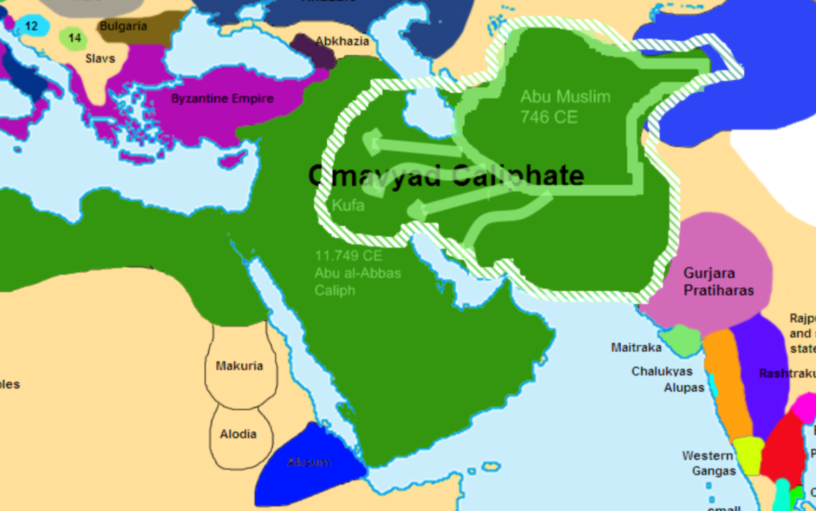Saviours or Destroyers of the Ummah?
By Mohamad Tarmizi
The Umayyad Caliphate was established by Mu’awiyah Ibn Abi Sufyan RA in 661 CE and it is considered to be the first Muslim dynasty in the Muslim world. It was established following the assassination of the caliph Ali RA and the abduction of Saidina Ali’s son, Hassan RA.
The Umayyad rulership was divided into two branches of the Umayyad family. The first one was from Abu Sufyan’s descendants: Mu’awiyah I, Yazid and Muawiyah II; and another branch was from Marwan’s family who ruled until the fall of the Umayyad dynasty in 750 CE.
After establishing the rulership, Mu’awiyah RA shifted the capital from Madina to Damascus. The main reason for this shift was related to the fact that, before becoming a caliph, he was the governor of Damascus and established his strong power and rallied support there. Damascus accordingly became his unshakable base as he had much more supporters there compared to Madina or Makkah.
The backbone for the Umayyad dynasty was the Syrian army consisting of loyal and zealot supporters of Mu’awiyah and his descendants. This army defended the government and contributed to the expansion of Islam to Central Asia and Sindh (Indian subcontinent).
As we know, at the end of the period of the righteously guided caliphs, the ummah had been disturbed by the rise of various problems such as the assassination of the caliph Uthman RA, the division of Muslims between Saidina Ali RA and Mu’awiyah RA, and civil wars that led to the assassination of the caliph Ali RA and the establishment of the Umayyad government. The Umayyads, accordingly, seems to be a controversial dynasty in Islamic history.
One of the reasons for such debate is due to the fact that the Umayyad practice of the appointment of rulers was deviated from the earlier Islamic practice of selection of the next ruler through Shura of Muslims. In addition, the tragedy of Karbala also contributed to the negative image of the Umayyads. Most of the Umayyad rulers, with exception of Umar ibn Abd Aziz, were problematic.
At the same time, we have to remember that what may could happen to Muslims if there was no strong power like the Umayyads at that difficult time when Muslims were facing threats from the Shiah or Khawarij branches who brutally claimed to be the rightest division in Islam. In addition, the Eastern Roman Empire was the bitter enemy of Muslim waiting for the right time to destroy the Muslim power and eliminate Islam.
Some of the Umayyad rulers were problematic, yet, the majority of them endeavoured to secure the unity of Muslims through establishing the strong central political entity and the strong army. As a result, it was during the Umayyad period that Islam expanded to its greatest extent. It was under the Umayyad that Islam spread to the Central Asia, Indian subcontinent, North Africa and Iberian Peninsula with the great numbers of the converts to Islam following the opening of new territories.
Mu’awiyah I, Marwan I, Abd Al- Malik, Al-Walid I and Umar ibn Abd Aziz succeeded in establishing the strong and effective central administration, to maintain peace and order in the Muslim world and newly opened territories.
After the reign of the caliph Umar ibn Abd Aziz, the Umayyad domination started to decline due to weaknesses of its rulers as well as internal and external disturbances. The Umayyad rule ended with the success of the Abbasid revolution in 750 CE and the defeat of the last Umayyad ruler at the battle of Zab. Most of the Umayyad family members were brutally killed, only one man from the Umayyad family, ‘Abd al-Rahman ibn Mu’awiya, was able to escape to Iberian Peninsula and established the second Umayyad rule there.
Now let me bring some examples of the contributions of the Umayyad rule to our ummah. For example, Dome of the Rock was built during the reign of ‘Abd Malik. Dome of the Rock was not a mosque but a monument symbolising the character of Islam and its domination in Jerusalem. It is believed that this is the site from where the Prophet Muhammad SAW ascended to the heaven. It was built at Jewish Temple Mount site, which was destroyed by the Romans on the order of the Emperor Titus. It also served as a pilgrimage site for a while when Hejaz was ruled by Ibn Zubayr, the enemy of the Umayyads.
Also, during the reign of ‘Abd Malik, coins with Islamic motifs inscribed with the Quranic verses began to be minted to replace Byzantine and Persian coins. Arabic language became the official state language to replace Byzantine and Persian languages in administration.
The Umayyads secured the Sunni dominance over the Muslim world making Shiah and Khawarij as minority groups. Islam spread to Central Asia, India, North Africa and Iberian Peninsula (Al-Andalus). The Umayyad army reached the Balkh, Caucasus and the lower Volga region. In 674-678, the Umayyad army sieged Constantinople due to the conflict between them and the Byzantine Empire. Yet, Constantinople will be opened only in 1453 by the great Muslim sultan, Mehmet II, the Liberator.
Reference:
The Umayyad : The First Muslim Dynasty
